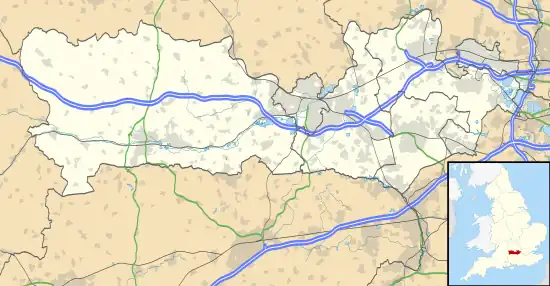| Aldworth | |
|---|---|
 St Mary's Church, Aldworth | |
 Rolling fields of barley and other crops in Aldworth with patched woodland. | |
 Aldworth Location within Berkshire | |
| Area | 9.06 km2 (3.50 sq mi) |
| Population | 296 (2011 census)[1] |
| • Density | 33/km2 (85/sq mi) |
| OS grid reference | SU5579 |
| Civil parish |
|
| Unitary authority | |
| Ceremonial county | |
| Region | |
| Country | England |
| Sovereign state | United Kingdom |
| Post town | Reading |
| Postcode district | RG8 |
| Dialling code | 01635 |
| Police | Thames Valley |
| Fire | Royal Berkshire |
| Ambulance | South Central |
| UK Parliament | |
| Website | Aldworth Village Community Website |
Aldworth is a village and mainly farmland civil parish in the English county of Berkshire, near the boundary with Oxfordshire.
Orthography and slight change of name
Aldworth was recorded in the Domesday Book of 1086 by scribes whose orthography was heavily geared towards French, lacking k and w, regulated forms for sounds ð and θ and ending many hard consonant words with e, as Elleorde, hinting at El(d)ward, the Old English for Old Ward i.e. Old farmed out (let) land Scribes in the 12th century rendered it at least once as Aldewurda.
Geography
Aldworth is in a rural area between Reading, Newbury and Streatley. It includes the hamlet of Westridge Green.[n 1] It lies on the high ground of the Berkshire Downs, just off the B4009 road between Newbury and Streatley. The Ridgeway, an 87-mile (140 km) pre-Roman footpath crosses the north of the parish.
History
King Alfred's defeat of the Danes at the Battle of Ashdown in January 871, is said by some to have occurred near The Ridgeway and Lowbury Hill.
In medieval times there was a fortified manor house or castle; La Beche Castle once stood on the site of what is now Beche Farm in the parish. This was the main residence of the De La Beche family, after whom it was named. This well-known family of medieval knights had held high positions at court since at least 1260. The De La Beche family remained powerful landowners and knights in the 14th century. Many were retainers to the king, warders to the Tower of London, and sheriffs of Oxfordshire and Berkshire. The family was influential in the reigns of Edward II and Edward III, and embroiled in the royal intrigue of the time. Sir Phillip was imprisoned in Scarborough Castle from 1322 to 1327, but later pardoned by Edward III. His father, also Sir Phillip, had been imprisoned and later pardoned under Edward II.
Amenities

A small area in the south of the village bears woodland centuries old that is still coppiced and carpeted with bluebells. It is open to the public subject to informal permission. The Bell Inn is a 15th-century inn that has twice won a National Pub of the Year award. [2] Another pub, The Four Points, stands at a crossroads south of the village centre.
Governance
Aldworth is a civil parish with an elected parish council. It belongs to the West Berkshire unitary authority and the parliamentary constituency of Newbury.
Parish church

The Church of England parish church of Saint Mary is a Grade I listed building, parts of which date back to the 12th century.[3]
The church contains numerous effigies to the De La Beche family. The collection holds the largest number of medieval memorials to a single family in any parish church. The figures are supposed to be life-size representations, but some of the knights are over seven feet tall, which has led to them being known as the Aldworth Giants. They were long thought to have been erected in the 1340s by the influential Sir Nicholas De La Beche (sometimes erroneously called Lord De La Beche), but historians now prefer to date them variously in the Middle Ages. A large number of the effigies were damaged by Parliamentarian iconoclasts during the English Civil War of the 17th century. Many of the knights are missing the lower part of their legs, noses and arms, presumably because these were easy parts to break off. Parliamentarians may have seen the giants as a symbol of royalty, although many churches were ransacked in the same period.
The poet, Laurence Binyon, moved to Westridge Green on his retirement in 1933.[4] After his death in 1943, his ashes were scattered in the churchyard, where there is a slate memorial plaque to him. The parents of Emily Tennyson, Lady Tennyson née Sellwood, the wife of Alfred, Lord Tennyson, are also buried there.
Demography
| Output area | Homes owned outright | Owned with a loan | Socially rented | Privately rented | Other | km2 roads | km2 water | km2 domestic gardens | Usual residents | km2 |
|---|---|---|---|---|---|---|---|---|---|---|
| Civil parish | 38 | 40 | 15 | 18 | 4 | 0.05 | 0.001 | 0.1 | 296 | 9.06 |
References
- 1 2 "Key Statistics: Dwellings; Quick Statistics: Population Density; Physical Environment: Land Use Survey 2005". Archived from the original on 11 February 2003. Retrieved 10 February 2022.
- ↑ "'Unchanged' family-run pub named best in the UK". BBC News. 12 February 2020. Archived from the original on 12 February 2020. Retrieved 12 February 2020.
- ↑ Historic England (24 November 1966). "Church of St. Mary (Grade I) (1313119)". National Heritage List for England.
- ↑ Christopher Winn: I Never Knew That about the River Thames (London: Ebury Press, 2010), p. 79.
Notes
Bibliography
- Page, William; Ditchfield, P.H., eds. (1924). A History of the County of Berkshire, Volume 4. Victoria County History. pp. 3–8.
- Pevsner, Nikolaus (1966). Berkshire. The Buildings of England. Harmondsworth: Penguin Books. pp. 63–65.